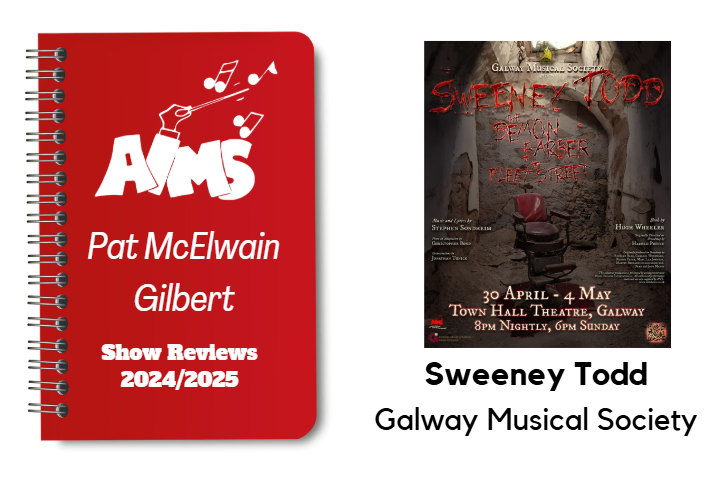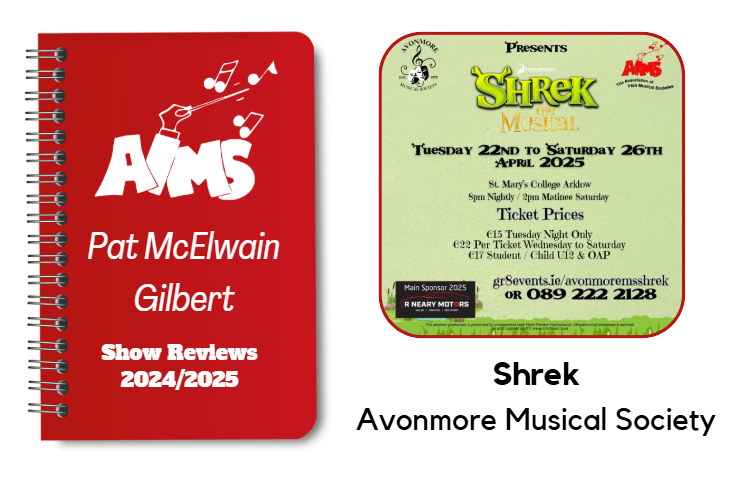Sweeney Todd as presented by Galway Musical Society
- Darragh Carroll

- 12 minutes ago
- 10 min read

Galway Musical Society
Sweeney Todd
Sunday 4th May 2025
Theatre often extends beyond entertainment. It can be thought-provoking. It can offer a sense of escapism. And even though we escape, the place to which we escape is not always a comfortable space. We can be forced to confront difficult issues and to think about challenging realities. Such was the case before the curtain even rose on Galway Musical Society's production of ‘Sweeney Todd’ in the Town Hall Theatre. The production utilised the interesting framing device of setting everything inside a bleak, 18th century mental asylum, with the cast, as inmates, drawing lots to assume the roles within Sondheim’s macabre masterpiece, which, in turn, played out in the asylum.
Sensitivity around the portrayal of mental illness and intellectual disability on stage can be problematic. There can be a fine line between such sensitivity and sensationalism. Art has an important role in informing and influencing attitudes and it is important that we do not portray mental illness through a caricatured lens. The wonderful ensemble in this production were present outside the theatre as we arrived. They sat and stood in silence and that silence was powerful in itself. What ensued in the theatre, as we took our seats, was altogether different. Ensemble members climbed over seats, some screeched, some wailed in distress, some stimmed, some rocked repetitively, some even screamed in audience members’ faces.
All of this disturbing behaviour was accompanied by a soundscape of unnerving music and eerie sound effects. For some audience members, this could have been very triggering. I felt that, had things been more muted, more measured, and less about the shock value, things may have been more grounded and authentic.
I was met with a wonderfully warm welcome and it was clear that my contact person had much experience in dealing with AIMS adjudicators in the past as she read my mind at every turn. A wonderful job, brilliantly executed, that will live long in the memory.
Paul Norton's direction was bold and often bizarre. With inmates assuming the roles of the story's twisted characters, it was quite the avant-garde interpretation, which gave us a haunting, thought-provoking spectacle and many moments of theatrical magic. The bag from which wigs, costume pieces and props, including the iconic rolling pin and razor, were passed to inmates, was a wonderfully original theatrical device, setting up the premise very nicely at the start of the show. The ensemble was incredibly committed to the Mr. Norton's vision. As good as it was, their background movement occasionally needed to be toned down as it drew focus. There was great fluidity in having cast orchestrate scene changes, minimising the need for blackouts and maintaining momentum throughout. Judge Turpin's despicable assault was graphic and disturbing, a real gut punch for the audience. Mr. Norton drew strong parallels between the madness of the inmates and the destructive obsessions of Sweeney Todd and Mrs. Lovett as the inmates’ despair and frustration with their confinement shaped the narrative. It was challenging for an audience on many levels, especially, I would suggest, for anyone unfamiliar with the tale of Sweeney Todd. For those who knew the show, this was quite the bold take, breathing new life into one of Sondheim’s most iconic works.
Musical director John Roe did an excellent job on this highly challenging show, with its intricate harmonies and complex structures. There was incredible harmony work, excellent diction, and a wonderful intensity to the superb chorus sound. Standout numbers included ‘The Ballad of Sweeney Todd’ and the brilliant ‘God, That's Good!.’ The choral elements of Sweeney Todd are essential to its dramatic impact and Mr. Roe ensured that there was drama aplenty as he created an exceptional sound with his wonderful cast. There was meticulous preparation and rehearsal evident in the impeccable timing and incredible balance of ‘The Ballad of Sweeney Todd’ and the deliciously complex ‘City on Fire.’ There was great collaboration with the sound department to ensure that Sondheim’s recurring leitmotifs were always clearly featured, underlining yet again the importance of music in supporting the narrative.
Jay Molyneux's choreography was innovative, inventive, and refreshing with very sharp, stylised movement, which reflected the broken minds and bodies of the inmates. The ensemble members were never merely background but rather a living representation of the fractured psyches which permeate the tale of Sweeney Todd. Movement was often unpredictable and unsettling, embodying the psychological and psychiatric chaos in what was a very strong metaphor for the human mind's eternal struggle. A wonderful job from Mr. Molyneux and his dedicated ensemble.
Alan Greaney was a very impressive Sweeney Todd. He was less brooding than some traditional characterisations, yet he was commanding in stature and speech with a great air of confidence. This was a more human characterisation, which invited the audience to empathise with his murderous tendencies. His descent into vengeance and rage mirrored the inmates’ own struggles with their demons. There was great power and nuance to his singing and his deeply resonant, baritone voice commanded authority. ‘Pretty Women’ was hauntingly good. You could cut the tension with a knife. He had an incredible emotional range, from his more thoughtful, introspective moments to his seething rage during ‘Epiphany’ which was a standout number.
Iona Ajisomo gave a very nuanced performance as Mrs. Lovett, playing the role quite differently, in a refreshing departure from convention that challenged our preconceptions of type. She was more glamorous than unkempt, in stark contrast to the grimness of her surroundings. This gave her a charm that endeared her to the audience. She was eerily seductive at times, although her amorous advances fell on deaf ears with Mr. Todd. Her beautifully clear, melodic voice was a delight. And her incredible diction in ‘A Little Priest’ was most impressive. She had a wonderful physicality which was fluid and dynamic and her comedic timing was exceptionally strong. Overall, an excellent portrayal with a refreshing take on the character that really worked.
I have been lucky enough to see Ethan Cassley play three very different roles this season. Every time he sets foot on stage; he brings an energy and a level of theatrical intelligence that just cannot be taught. His Tobias continued in that vein. This was a stunning performance. Mr. Cassley’s vocal was haunting and his vulnerability and emotional investment in ‘Not While I'm Around’ was one of the high points of the show. His crumbling mental state as the show progressed was very well judged. My only thought was that his psychological demise might have been even more harrowing had he not been surrounded by the large ensemble of fractured minds. His pleading with Mrs. Lovett to wake up was simply heartbreaking, a beautifully played scene. A top-notch portrayal from one of the country’s most talented young performers. Remember the name.
Martin McNelis brought much authoritarian cruelty to his portrayal of the sinister Judge Turpin. Mr. McNelis was a most creepy, intimidating character and his fixation with Johanna's “light muslin gown” made everyone's skin crawl. His fabulous lower register in ‘Pretty Women’ was quite hypnotic and he blended so well with Mr. Greaney. The monster of a song that is ‘Johanna (Mea Culpa)’ was brilliantly executed in a most disturbing performance which was graphic and unsettling in the extreme.
Eimear Wolohan brought a beautiful fragility to her portrayal of Johanna. Her singing was stunning with a gorgeous soprano in ‘Green Finch and Linnet Bird.’ This was made all the better by her exquisite diction and clarity throughout. ‘Kiss Me’ with Anthony was a gorgeous, most earnest duet and Ms. Wolohan was suitably naive in her scenes with Judge Turpin.
Keith Hanley underlined his wonderful reputation as a highly intelligent actor in his portrayal of Anthony Hope. Indeed, he played the role with much hope and optimism. His fabulous tenor voice and superb interpretation of lyrics made this a standout performance. ‘Kiss Me’ with Joanna was beautifully performed but it was the stunning ‘Johanna’ which impressed the most as Mr. Hanley’s soaring vocals connected so intensely with the lyrics.
Brandon Collier was a rather violent and sinister Beadle Bamford. This was juxtaposed with a comedic, almost camp delivery. ‘Ladies in Their Sensitivities’ featured Mr. Collier's fine vocal range and he was very funny as he played the harmonium. Diction and presence were excellent throughout and Mr. Collier really got under the skin of this slimy character.
Aisling Nolan was a tormented Beggar Woman. This too was an excellent characterisation.Ms. Nolan had a wonderfully haunting, soprano voice. However, in the ‘Johanna (reprise)’ in Act Two, diction was compromised by the frenetic energy of her characterisation. It can be a fine line, but lyrics must trump all.
Niall Conway was an excellent Adolfo Pirelli. This was a hilariously funny performance and Mr. Conway's faux Italian accent played with over-the-top delight was superb. The revelation of his perfectly articulated Northern Irish brogue was a comic highlight and a much-needed tension breaker. This was a perfect example of making the most of every moment on stage and Mr. Conway brought his vast experience in creating a fabulous character.
Jay Hall played Jonas Fogg, proprietor of the asylum, quite brilliantly. The biggest compliment that I can pay Mr. Hall is that I wished that Jonas had a lot more to do in the show. His physicality, focus and attention to narrative detail was excellent in what was a really strong portrayal.
The ensemble in this show was simply astonishing at times. From the moment we encountered them outside the theatre, they were always working, with no let-up, spending most of the show visible on stage. This requires an incredible amount of focus and attention.It is very difficult to sustain, both mentally and physically, and I'm sure they must have been exhausted after every performance. They brought tension and unpredictability to the unsettling surrounds of the asylum. Sometimes it is the simple things that stand out the most.
The eerie stillness of these tormented souls after Tobias cut Sweeney's throat was a most memorable moment, beautifully played by all. Movement was incredible and this group was perfectly in tune with Mr. Molyneux’s stylistic choices for the show's choreography. Chorally, this was an outstanding job from all involved, with stunning balance and incredible interpretation within the complex harmonies and structures of Mr. Sondheim's arrangements.
Stage manager, Chontelle Kenny, ensured that this show moved along at a cracking pace.There was brilliant use of cast for choreographed, featured scene changes and everything was slick and well-timed throughout. One small hiccup occurred when Anthony banged on the door in Fogg's Asylum, shouting for it to be opened as he searched for Johanna. Unfortunately, the door unexpectedly swung open of its own accord. Mr. Hanley simply didn't know his own strength! But that's live theatre and these things can happen.
The set was quite stunning. with everything framed within the foreboding confines of the oppressive asylum. The cold, wet walls and flickering lights echoed its inhabitants' psyches in what looked like a most oppressive atmosphere. Rivetted doors, Sweeney's barbershop, the detail of the bell at the bottom of the stairs, all added to a most authentic visual spectacle. The upper levels provided some wonderful staging opportunities and the ominously barred doors were a reminder that the theme of imprisonment, both physical and mental, was always to the fore.
Lighting was simply stunning throughout the show, with great use of shadow reflecting the darkness of the inmates' minds and their disorienting environment. Blackouts were often unnecessary as cast changed scenes in a choreographed seamless manner. There was great use of low fog and haze in the creation of this dark, sinister world. Stunningly dramatic beams sliced through haze, creating a disturbing visual for the unnerving ‘Johanna (Mea Culpa).’ Mr. McNelis' excellent performance was accentuated by stunning lighting and smoke effects. Likewise, there was superb work in the amazing ‘Epiphany’ as Todd descended into a vengeful madness. There was great creation of focus in the separation between ensemble and main players throughout the show. The ensemble, who surrounded the main playing space, were often lit in a more shadowy, otherworldly state. I loved the recurring dramatic red for Sweeney's kills and the final shaft of light pouring in through the door at the end of the show was a visually stunning picture.
Sound was excellent throughout. There was superb balance within the orchestra and an outstanding stage/pit balance. Choral singing was perfectly mixed. EQ levels for dialogue were very well handled and cueing for microphones was exceptionally strong, apart from one minor slip towards the end of the show, with Mrs. Lovett's mic. Sound effects were appropriate and excellently timed throughout. A really strong job overall.
Props were excellent. From the production of iconic props from the bag at the top of the show, such as the rolling pin and the razor, it was clear that a lot of work had gone into getting things just right. The bird cages on poles were excellent, and there was great attention to detail for bottles of miracle elixir, shaving brushes, and cream, and of course, Sweeney's razors which were all very authentic. The fabulous harmonium looked wonderful, and I loved the detail of the quill and ink pot on top of the harmonium. Fogg's antique scissors was an incredibly authentic piece.
Costumes, which were all individually made and tailored for the cast, were simply wonderful.It was clear from the outset that meticulous detail had gone into every single costume on the stage and this detail really showed. Simple things like the beggar woman's ripped skirt, and the visually appeal of Pirelli's red and gold waistcoat were superb. I also loved the wonderfully grotesque animal masks. Everything was carefully planned and appeared authentic to the era, in what was a brilliantly costumed show.There was incredible attention to detail in the hair and makeup plot also, especially for the inmates, whose hair and open wounds and scabs, darkened eyes, and pale faces suggested that they had never seen the light of day. Joanna's blonde wig was most natural-looking, and Mrs. Lovett's makeup looked more glamorous than grimy, but really added to her quirky characterisation. The beggar woman’s red raw knees were a visceral reminder of her having fallen on such desperate times.
This was a brave and bold reimagining of Sondheim's macabre masterpiece, which challenged its audience through its chaotic, haunting, and theatrical storytelling. It was a superb production from an incredibly talented cast, crew, and creative team. Huge congrats to all on such a wonderful job.
Pat McElwain
Gilbert Adjudicator 2024/2025
Photos by Martina O'Brien


























































Comments